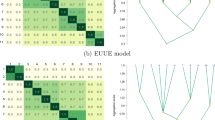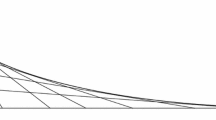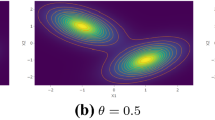Abstract
This paper presents a new methodology concerned with the estimation of ultrametric trees calibrated on subjects' pairwise proximity judgments of stimuli, capturing subject heterogeneity using a finite mixture formulation. We assume that a number of unobserved classes of subjects exist, each having a different ultrametric tree structure underlying the pairwise proximity judgments. A new likelihood based estimation methodology is presented for those finite mixtures of ultrametric trees, that accommodates ultrametric as well as other external constraints. Various assumptions on the correlation of the error of the dissimilarities are accommodated. The performance of the method to recover known ultrametric tree structures is investigated on synthetic data. An empirical application to published data from Schiffman, Reynolds, and Young (1981) is provided. The ability to deal with external constraints on the tree-topology is demonstrated, and a comparison with an alternative clustering based method is made.
Similar content being viewed by others
References
Aitkin, M., & Rubin, D. B. (1985). Estimation and Hypothesis Testing in Finite Mixture Distributions.Journal of the Royal Statistical Society, Series B,47, 67–75.
Allenby, G. M. (1989). A unified approach to identifying, estimating and testing demand structures with aggregate scanner data.Marketing Science, 8, 265–280.
Amemiya, T. (1985).Advanced economics. Cambridge: Harvard University Press.
Aptech (1995).Constrained maximum likelihood, GAUSS manual. Maple Valley, WA: Aptech systems.
Bozdogan, H. (1987). Model selection and Akaike's information criterion (AIC): The general theory and its analytical extensions.Psychometrika, 52, 345–370.
Carroll, J. D. (1976). Spatial, non-spatial and hybrid models for scaling.Psychometrika, 41, 439–463.
Carroll, J. D., Clark, L., & DeSarbo, W. S. (1984). The representation of three-way proximities data by single and multiple tree structure models.Journal of Classification, 1, 25–74.
Carroll, J. D., & Pruzanski, S. (1980). Discrete and hybrid scaling models. In E. D. Lanterman & H. Feger (Eds),Similarity and Choice, (pp. 48–69). Bern: Hans Huber.
Corter, J. E. (1996).Tree models of similarity. London: Sage.
Corter, J. E., & Tversky, A. (1986). Extended Similarity Trees.Psychometrika, 51, 429–451.
Dempster, A. P., Laird, N. M., & Rubin, R. B. (1977) Maximum likelihood from incomplete data via the EM-algorithm.Journal of the Royal Statistical Society, Series B,39, 1–38.
DeSarbo, W. S., & Mahajan, V. (1984). Constrained classification: the use of a priori information in cluster analysis.Psychometrika, 49, 187–215.
DeSarbo, W. S., Manrai, A. K., & Manrai, L. A. (1993). Non-Spatial Tree Models for the Assessment of Competitive Market Structure: An Integrated Review of the Marketing and Psychometric Literature. In J. Eliashberg & G. L. Lilien (Eds.),Handbooks in operations research and management science: Marketing (pp. 193–257). Amsterdam: Elsevier Science Publishers.
DeSoete, G. (1983). A least squares algorithm for fitting trees to proximity data.Psychometrika, 48, 621–626.
Ferligoj, A., & Batagelj, V. (1982). Some types of clustering with relational constraints.Psychometrika, 47, 541–552.
Gordon, A. D. (1973). Classification in the presence of constraints.Biometrics, 29, 821–827.
Gordon, A. D. (1980).Classification. London: Chapman and Hall.
Hartigan, J. A. (1967). Representation of similarity matrices by trees.Journal of the American Statistical Association, 62, 1140–1158.
Jamshidian, M., & Bentler, P. M. (1993). A modified Newtone method for constrained estimation in covariance structure analysis.Computational Statistics and Data Analysis, 15, 133–146.
Johnson, S. C. (1967). Hierarchical Clustering Schemes.Psychometrika, 32, 241–254.
Lindsey, J. K. (1993).Models for repeated measurements. Oxford: Clarendon Press.
Morgan, B. T., & Ray, A. P. G. (1995). Non-uniqueness and inversion in cluster analysis.Applied Statistics, 44, 117–134.
Payne, R. W., et al. (1993).GENSTAT 5 Reference manual. Oxford: Clarendon Press.
Ramsay, J. O. (1977). Maximum likelihood estimation in multidimensional scaling.Psychometrika, 42, 241–266.
Rao, V. R., & Sabavala, D. J. (1981). Inference of hierarchical choice processes from panel data.Journal of Consumer Research, 8, 85–96.
Roux, M. (1987). Techniques of Approximation for Building Two Tree Structures.Proceedings of the Franco-Japanese Scientific Seminar: Recent Developments in Clustering and Data-Analysis, 4, 127–146.
Sattah, S., & Tversky, A. (1977). Additive Similarity Trees.Psychometrika, 42, 319–345.
Scales, L. E. (1985).Introduction to non-linear optimization. London: MacMillan.
Schiffman, S. S., Reynolds, M. L., & Young, F. W. (1981). Introduction to multidimensional Scaling. London: Academic Press.
Srb, A. M., Owen, R. D., & Edgar, R. S. (1965).General genetics. San Francisco: Freeman.
Titterington, D. M., Smith, A. F. M., & Makov, U. E. (1905). Statistical analysis of finite mixture distributions. New York: John Wiley.
Tversky, A. (1977). Features of similarity.Psychological Review, 84, 327–352.
Wedel, M., & DeSarbo, W. S. (1994). A Review of Recent Developments in Latent Class Regression Models. In R. P. Bagozzi (Ed.),Advanced methods of marketing research (pp. 352–388). Cambridge: Blackwell.
Wedel, M., & DeSarbo, W. S. (1995). A mixture likelihood approach for generalized linear models.Journal of Classification, 12, 21–56.
Wedel, M., & DeSarbo, W. S. (1996). An exponential family mixture MDS methodology for simultaneous segmentation and product positioning.Journal of Business and Economic Statistics, 14, 447–459.
Wedel, M. & Kamakura, W. A. (1997).Market segmentation: Conceptual and mathodological foundations. Dordrecht: Kluwer.
Author information
Authors and Affiliations
Additional information
The authors wish to thank the Editor, Associate Editor, and two anonymous reviewers for their excellent comments and suggestions which helped improve the manuscript.
Rights and permissions
About this article
Cite this article
Wedel, M., DeSarbo, W.S. Mixtures of (constrained) ultrametric trees. Psychometrika 63, 419–443 (1998). https://doi.org/10.1007/BF02294863
Received:
Revised:
Issue Date:
DOI: https://doi.org/10.1007/BF02294863




